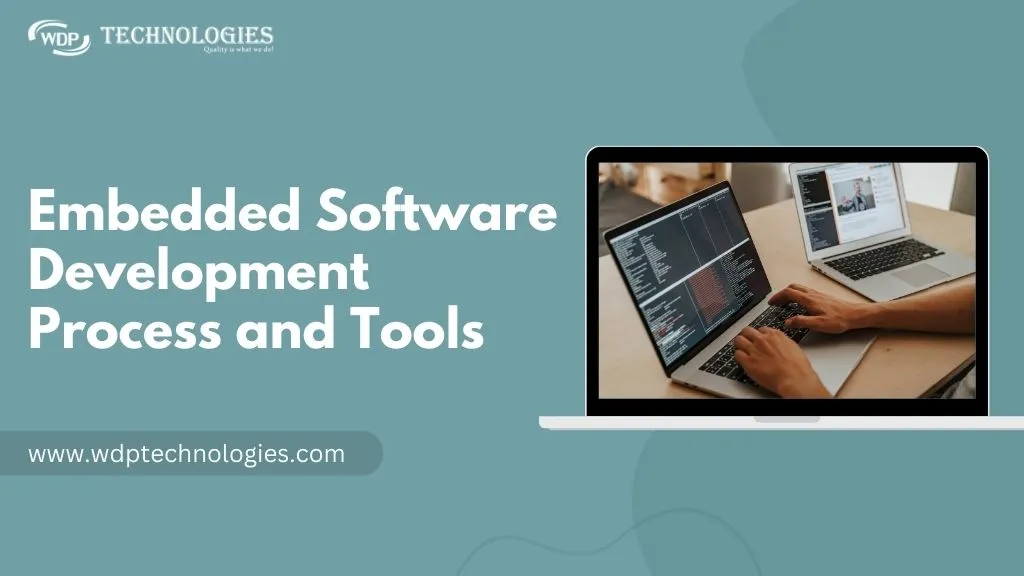Embedded systems have become an integral part of our daily lives, powering a wide range of devices, from smartphones and smart home appliances to medical devices and automotive systems. Embedded software is the code that runs on these systems, and its development is a complex and critical task. In this blog, we will explore the embedded software development process and tools that facilitate this process.
Understanding Embedded Software
Embedded software, often referred to as firmware, is computer code that is written to control a specific hardware device or system. It is designed to perform dedicated functions and is typically more resource-constrained than general-purpose software. Embedded software interacts closely with the hardware it runs on, and its development process must consider factors such as memory limitations, processing power, real-time requirements, and reliability.
Embedded Software Development Process
The embedded software development process is a structured and iterative approach to creating, testing, and maintaining firmware for embedded systems. This process typically consists of several key stages:
1. Requirements Analysis
The process begins with a clear understanding of the system’s requirements. Developers work closely with domain experts to define the functionalities, constraints, and performance expectations. This step is crucial because misunderstanding or misinterpretation of requirements can lead to costly errors later in the development process. The process often involves detailed documentation of the system’s expected behavior, response times, and any regulatory standards that must be met.
2. Architecture and Design
Once requirements are established, developers create a high-level architectural design. This design outlines the software’s structure, how it will interact with hardware, and any necessary interfaces. Architectural decisions made during this phase can significantly impact the efficiency and maintainability of the embedded software. Design patterns, such as the Model-View-Controller (MVC) pattern, are commonly used to structure the software.
3. Coding
This is the phase where developers write the actual code. Embedded software developers use programming languages like C and C++ to develop firmware. These languages are preferred because of their low-level capabilities and close interaction with hardware. The code is optimized for resource utilization and real-time performance. Developers must also be mindful of code efficiency, as resource-constrained systems require careful management of memory and processing power.
4. Testing
Rigorous testing is a critical step in embedded software development. This includes unit testing to verify individual components, integration testing to ensure they work together, and system testing to validate the entire system’s functionality. Testing is often divided into several categories:
a. Unit Testing
Unit testing focuses on verifying the functionality of individual modules or functions within the software. This is essential for identifying and fixing bugs and issues at an early stage. Automated testing frameworks like Ceedling and Unity can help streamline the unit testing process.
b. Integration Testing
Integration testing is necessary to ensure that different software components interact correctly. It verifies that interfaces between software modules are functioning as intended and that data is being passed correctly between them.
c. System Testing
System testing validates the entire embedded system’s functionality. This includes testing various system states, input scenarios, and boundary conditions. It ensures that the embedded software meets its intended purpose.
5. Debugging and Optimization
Embedded software often needs fine-tuning to meet performance and resource constraints. Debugging tools and techniques, such as in-circuit emulators, logic analyzers, and real-time debugging tools, are used to identify and rectify issues. Developers must be proficient in debugging to pinpoint and resolve problems efficiently.
Optimization involves improving code efficiency and reducing resource consumption. This may involve rewriting code, eliminating redundancy, or employing techniques like code profiling to identify performance bottlenecks.
6. Documentation
Proper documentation is essential for maintaining and updating embedded software. Clear and well-organized documentation facilitates collaboration among developers and helps future maintainers understand the software’s architecture and functionality. Documentation includes code comments, user manuals, and design documents.
7. Validation and Verification
The software is validated to ensure it meets the specified requirements, and it is verified for compliance with industry standards and regulations. Validation and verification are distinct processes:
a. Validation
Validation confirms that the embedded software meets the customer’s or end-user’s needs. It ensures that the software provides the desired functionality and performs as expected in its intended environment.
b. Verification
Verification, on the other hand, focuses on whether the software conforms to predefined standards and specifications. This includes checking if the software adheres to coding standards, design guidelines, and regulatory requirements.
8. Deployment and Maintenance
Once the software is ready, it is deployed on the target hardware. Deployment may involve programming microcontrollers, flashing firmware, or installing software on the embedded system. After deployment, maintenance becomes a continuous process. It includes periodic updates, bug fixes, addressing security vulnerabilities, and adapting to changing requirements or environments.
Tools for Embedded Software Development
The development of embedded software requires specialized tools to handle the unique challenges associated with resource-constrained systems. Here are some essential tools used in the embedded software development process:
1. Integrated Development Environments (IDEs)
Integrated Development Environments provide a unified platform for writing, compiling, and debugging embedded code. They often come with simulator and debugger support. Some popular IDEs for embedded development include:
a. Eclipse: An open-source IDE that supports multiple programming languages and has a range of plugins available for embedded development.
b. Keil: A popular choice for developing software for microcontrollers, Keil provides a robust development environment and debugger tools.
c. IAR Embedded Workbench: Known for its optimization capabilities, IAR is widely used in embedded development, particularly for ARM-based systems.
2. Compiler and Cross-Compiler
Embedded systems typically use specific compilers tailored to the target hardware. Cross-compilers generate code for a different architecture or platform than the one they run on. The choice of compiler can significantly impact code efficiency and performance. Some well-known compilers include:
a. GCC (GNU Compiler Collection): A popular open-source compiler that supports various architectures and is widely used in the embedded development community.
b. ARM Compiler: Designed for ARM-based microcontrollers, this compiler is known for generating efficient code for ARM processors.
3. Debugger Tools
Debuggers are essential for tracing and resolving issues in embedded software. They help developers examine the program’s execution, set breakpoints, and interactively inspect variables and memory. Common debugger tools include:
a. GDB (GNU Debugger): A versatile debugger that is widely used in the open-source community. It supports various platforms and hardware targets.
b. JTAG Debuggers: Joint Test Action Group (JTAG) debuggers are hardware tools that allow low-level debugging of embedded systems. They connect to JTAG ports on microcontrollers for in-circuit debugging.
4. Emulators and Simulators
Emulators and simulators allow developers to test and debug software on a host system before deploying it on the actual embedded hardware. They are invaluable for early development and testing, as they provide a controlled environment for testing without the need for the physical hardware. Some popular emulation and simulation tools include:
a. QEMU: A versatile open-source emulator that supports various architectures. It allows for the simulation of embedded systems without the need for the physical hardware.
b. Simulink: MATLAB Simulink is often used for modeling and simulating embedded systems, making it easier to understand and test the system’s behavior before implementing it in code.
5. Version Control Systems
Version control systems are crucial for tracking changes, maintaining code history, and collaborating with other developers on embedded projects. They help prevent conflicts, track issues, and enable teams to work on different aspects of the software simultaneously. Popular version control systems include:
a. Git: A widely used distributed version control system known for its flexibility and efficiency in managing code repositories.
b. SVN (Subversion): A centralized version control system that provides robust version tracking and collaborative features.
6. Real-Time Operating Systems (RTOS)
In embedded systems with real-time requirements, an RTOS is crucial for managing task scheduling and resource allocation. RTOSs help ensure that critical tasks are executed within specified time constraints. Some notable RTOSs are:
a. FreeRTOS: A popular open-source real-time operating system known for its versatility and small footprint.
b. VxWorks: A commercial RTOS with a long history of use in mission-critical applications such as aerospace and industrial automation.
c. QNX: Known for its reliability and real-time capabilities, QNX is often used in embedded systems where high levels of determinism are required.
7. Static Analysis Tools
Static analysis tools help ensure code quality, compliance with coding standards, and the identification of potential issues before they become problems. These tools perform automated checks to enforce coding guidelines and identify potential vulnerabilities. Some widely used static analysis tools are:
a. Lint: A static code analysis tool that identifies issues in C and C++ code, helping developers follow coding standards.
b. MISRA C: A set of software development guidelines for C language developed by the Motor Industry Software Reliability Association (MISRA). Tools like MISRA Compliance Checker help ensure compliance with these guidelines.
8. Hardware Description Languages (HDL)
For embedded systems that incorporate FPGAs or custom hardware, hardware description languages (HDL) like Verilog or VHDL are used to describe and program hardware components. HDLs enable developers to create custom logic that interfaces with the embedded software.
9. Automated Testing Frameworks
Automated testing frameworks simplify unit testing, enabling developers to verify individual code components. These frameworks often provide test runners and assertion libraries, making it easier to write and execute tests. Some notable automated testing frameworks are:
a. Ceedling: A test framework for C code that integrates with CMock and Unity, simplifying unit testing for embedded systems.
b. Unity: A lightweight unit testing framework for C that is commonly used in embedded software development.
Real Challenges in Embedded Software Development Process and Tools
Embedded software development process and tool is a challenging and complex task, and there are many real-world challenges that developers must face. These challenges can be broadly categorized into the following areas:
🔹 Hardware constraints: Embedded systems often have limited resources, such as processing power, memory, and storage. This can make it difficult to develop software that is both efficient and performant. Developers must carefully consider the hardware constraints of the target device and optimize their code accordingly.
🔹 Real-time performance: Many embedded systems have real-time requirements, meaning that they must respond to events within a strict time frame. This can be a difficult challenge to meet, especially when the system is under heavy load. Developers must use techniques such as real-time operating systems (RTOS) and priority scheduling to ensure that real-time requirements are met.
🔹 Reliability and safety: Embedded systems are often used in critical applications, such as medical devices, automotive systems, and industrial control systems. In these applications, failures can have serious consequences. Developers must use rigorous testing and verification techniques to ensure that embedded software is reliable and safe.
🔹 Security: Embedded systems are increasingly being connected to the Internet of Things (IoT), which makes them vulnerable to cyberattacks. Developers must take steps to secure embedded systems, such as using encryption and access control mechanisms.
🔹 Power consumption: Battery-powered embedded systems must be designed to operate for as long as possible on a single charge. This can be a challenge, especially when the system is performing complex tasks. Developers must use techniques such as low-power modes and energy-efficient algorithms to reduce power consumption.
🔹 Maintenance: Embedded systems often have a long lifespan, so it is important to design software that can be easily maintained. This includes using modular code, clear documentation,
Contact us : Best Software Development
Conclusion
Embedded software development process and tool is a complex and highly specialized field that demands careful planning, rigorous testing, and the use of appropriate tools. As technology continues to advance, embedded systems will become increasingly integral to various industries, and the role of embedded software in these systems will continue to grow in importance. Staying up-to-date with the latest tools and practices is crucial for embedded software developers to meet the evolving demands of this field.
With the growth of the Internet of Things (IoT), where embedded systems are at the core of interconnected devices, the need for skilled embedded software developers and the right tools has never been greater. As we move forward, embedded software development will continue to be a dynamic and exciting field, driving innovation in diverse applications, from healthcare to transportation and beyond. Embracing the best practices and tools outlined in this blog will undoubtedly help developers navigate the challenges and opportunities that lie ahead in the world of embedded systems.












